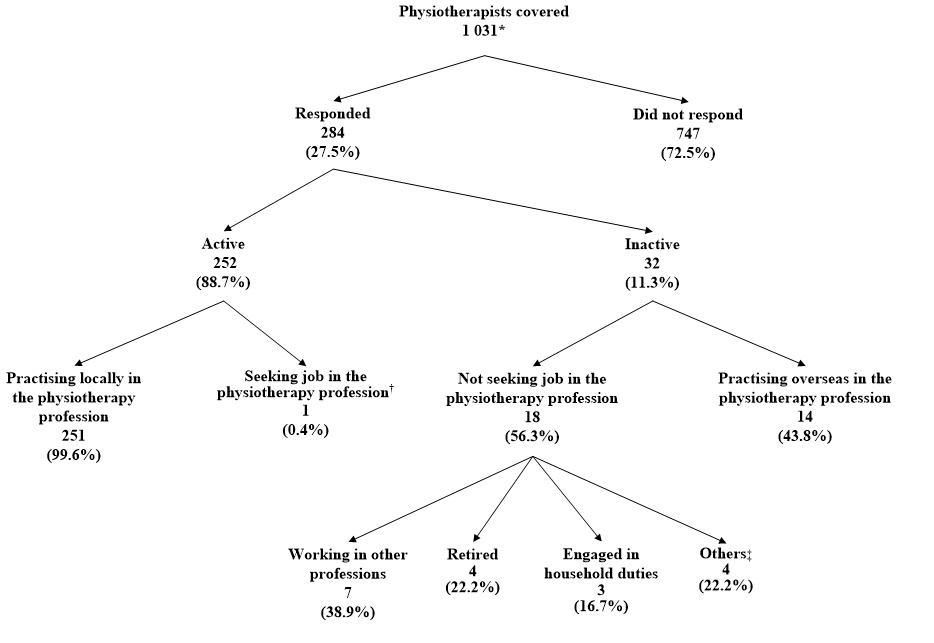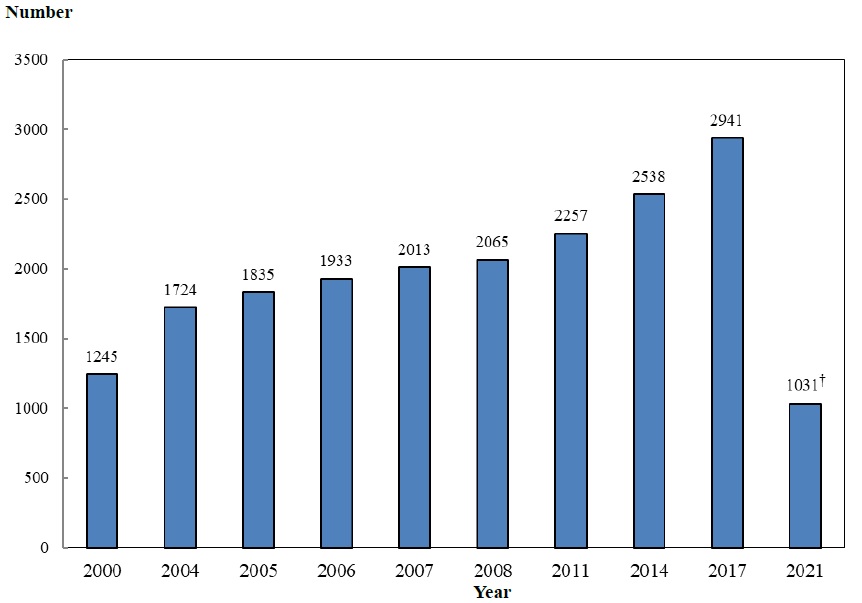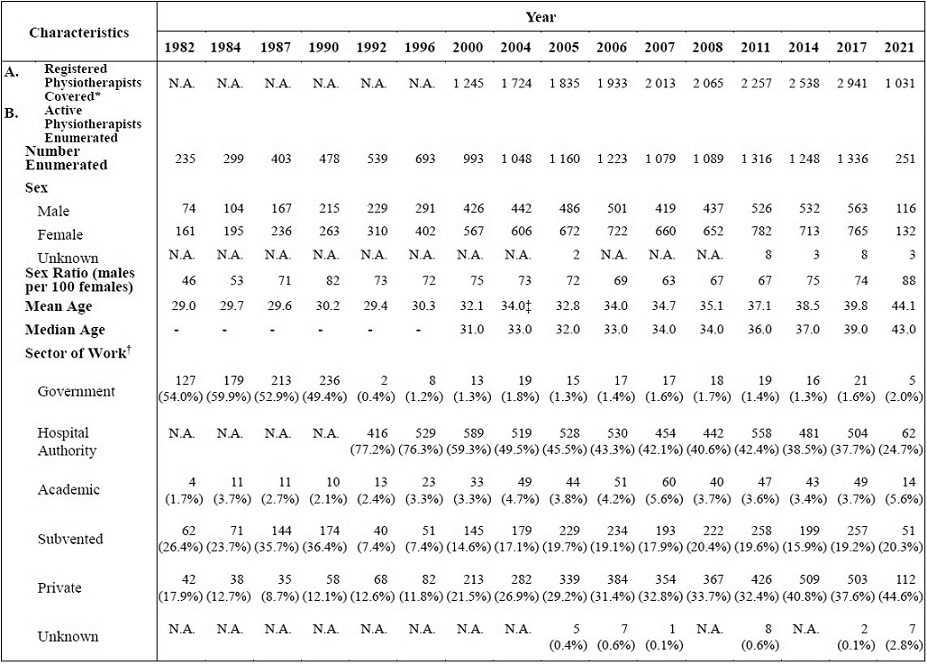Statistics
2021 Health Manpower Survey
Summary of the Characteristics of Physiotherapists Enumerated
I. Physiotherapists Covered
1.1 The physiotherapists covered in the 2021 Health Manpower Survey on Physiotherapists (HMS-PT) were physiotherapists registered with the Physiotherapists Board of Hong Kong under the Supplementary Medical Professions Ordinance (Chapter 359) as at the survey reference date of 31 July 2021, and who had provided written consent on receiving information related to HMS-PT by post or email.
1.2 Among the 3 919 physiotherapists registered with the Physiotherapists Board of Hong Kong as at the survey reference date of 31 July 2021, 1 031 had consented to receive information related to HMS-PT by post or email. The number of physiotherapists covered was 1 031.
II. Response Rate
2.1 Of the 1 031 physiotherapists covered, 284 responded to the HMS-PT, giving an overall response rate of 27.5% (Chart A).
III. Activity Status
3.1 The responding physiotherapists were classified as either “economically active”* or “economically inactive”*. Economically active (“active”) physiotherapists included:
(a) “employed” physiotherapists - physiotherapists practising in the physiotherapy profession in Hong Kong during the survey period; and
(b) “unemployed” physiotherapists - physiotherapists who (i) were not practising in the local physiotherapy profession during the survey period; (ii) had been available for work during the seven days before the survey† AND (iii) had sought work in the local physiotherapy profession during the 30 days before the survey‡.
3.2 Economically inactive (“inactive”) physiotherapists referred to the responding physiotherapists who were not practising in the physiotherapy profession in Hong Kong during the survey period, excluding those who were on leave during the survey period and who were “economically active” but “unemployed”.
3.3 Among the 284 responding physiotherapists, 252 (88.7%) were active and 32 (11.3%) were inactive in the local physiotherapy profession as at 31 July 2021 (Chart A).
| * | In the survey, the criteria used in defining economically active / inactive followed those recommended by the International Labour Organization, which are also being used by the Census and Statistics Department in Hong Kong. |
| † | The respondent would be classified as “unemployed” if he / she had sought work in the local physiotherapy profession but had not been available for work because of temporary sickness. |
| ‡ | The respondent would also be classified as “unemployed” if he / she fulfilled conditions (i) and (ii) but had not sought work during the 30 days before enumeration because he / she believed that work was not available; or had made arrangements to take up a new job; or was starting business on a subsequent date; or was expecting to return to the original job in the local physiotherapy profession. |
3.4 Of the 252 active physiotherapists, 251 (99.6%) were practising in the local physiotherapy profession and one (0.4%) was seeking job in the physiotherapy profession. The survey results presented in paragraph 3.5 to 3.15 below were based on the 251 responding physiotherapists who were practising in the local physiotherapy profession as at 31 July 2021. The percentages presented below may not add up to 100% due to missing responses or rounding (Chart A).
3.5 Of the 32 (11.3%) inactive physiotherapists enumerated, 18 (56.3%) reported not seeking jobs in the local physiotherapy profession during the 30 days before enumeration and 14 (43.8%) reported practising overseas. Among the 18 inactive physiotherapists who reported not seeking jobs in the local physiotherapy profession, the main reasons included: seven (38.9%) were working in other professions, four (22.2%) were retired, three (16.7%) were engaged in household duties, three (16.7%) reported as wanting to take rest/ had no motive to work/ had no financial need and one (5.6%) had emigrated (Chart A).
3.6 Of the 251 active physiotherapists practising in the local physiotherapy profession enumerated, there were 116 (46.2%) male, 132 (52.6%) female and three (1.2%) did not indicate the gender, giving an overall sex ratio (males per 100 females) of 88. Excluding two respondents who did not indicate their ages, the median age of the remaining 249 was 43.0 years (median age of female was 43.0 years and median age of male was 44.0 years).
3.7 The responding active physiotherapists practising in the local physiotherapy profession were requested to indicate the characteristics of their main jobs*. Of the 251 respondents, 112 (44.6%) reported as working in private sector, 62 (24.7%) were working in the Hospital Authority, 51 (20.3%) were working in subvented sector, 14 (5.6%) were working in academic sector, five (2.0%) were working in the Government sector and seven (2.4%) did not indicate the sectors for their main jobs.
3.8 For the active physiotherapists practising in the local physiotherapy profession enumerated, the median age for those working in academic sector was 55.5 years, whereas the median ages for those working in the Hospital Authority and for those working in the Government were 45.5 years and 45.0 years respectively.
3.9 Of the 251 active physiotherapists practising in the local physiotherapy profession enumerated, 75.3% reported spending most of their working time on rehabilitation, while 11.2% reported spending most of their working time on administration/ management, 6.4% reported primary health care†, 5.6% reported teaching and 1.2% reported research as the main area of work.
3.10 Excluding one active respondent who did not indicate his / her hours of work per week (excluding meal breaks), the median number of hours of work per week (excluding meal breaks) of the remaining 250 active physiotherapists practising in the local physiotherapy profession enumerated was 44.0 hours. Among them, 21 (8.4%) were required to undertake on-call duty (excluding normal duty), with a median of 8.0 hours of on-call duty (excluding normal duty) per week.
3.11 Among the 251 respondents, 58.2% held Bachelor’s Degree, 24.3% held Professional Diploma and 13.9% held Master’s Degree as their earliest basic qualification.
| * | Main jobs referred to the jobs in which the Physiotherapists had spent most of their working time. |
| † | Refers to work such as health education, health promotion, or work involving patient care in the primary care setting. |
Chart A : Activity Status of Physiotherapists Covered

| Note: | * | Figure refers to the number of physiotherapists who had registered with the Physiotherapists Board of Hong Kong under the Supplementary Medical Professions Ordinance (Chapter 359) on or before 31.7.2021, and who had provided written consent to receive information related to HMS-PT by post or email. |
| † | Figure refers to the number of responding physiotherapists who (a) were not practising in the physiotherapy profession in Hong Kong during the survey period; (b) had been available for work during the seven days before the survey; AND (c) had sought work in the local physiotherapy profession during the 30 days before the survey. | |
| ‡ | Figure refers to the number of responding physiotherapists who reported as wanting to rest/ no motive to work/ no financial need or having emigrated. | |
| Percentages may not add up to 100% due to rounding. |
3.12 Of the 251 respondents, 210 (83.7%) had received/ were receiving additional training after obtaining the earliest basic qualification, amongst which 124 (59.0%) held Master’s Degree, 26 (12.4%) held Certificate and 22 (10.5%) held Doctoral Degree as the highest qualification and two (1.0%) had not yet completed the additional training.
3.13 Of the 210 respondents who had received/ were receiving additional training after obtaining the earliest basic qualification, 88 (41.9%) had received/ were receiving training in one field only, which included training in acupuncture (23.9%), sports physiotherapy/ sports and health science (22.7%), rehabilitation (11.4%), manipulative physiotherapy (9.1%), rehabilitation sciences/ studies (9.1%) and health care management/ health services management (8.0%).
3.14 Of the 210 active physiotherapists practising in the local physiotherapy profession who had received/ were receiving additional training after obtaining the earliest basic qualification, 121 (57.6%) indicated that they had received/ were receiving more than one field of additional training. The most commonly reported fields included: acupuncture which was reported by 103 (85.1%) of the 121 respondents, manipulative physiotherapy which was reported by 55 (45.5%) of the respondents, sports physiotherapy/ sports and health sciences which was reported by 44 (36.4%) of the respondents, health care management/ health services management which was reported by 31 (25.6%) of the respondents, physiotherapy which was reported by 31 (25.6%) of the respondents and rehabilitation sciences/ studies which was reported by 29 (24.0%) of the respondents.
3.15 Among the 251 active physiotherapists practising in the local physiotherapy profession, 154 (61.4%) reported that they had participated in Continuing Professional Development (CPD) activities in 2021, 95 (37.8%) reported no participation in any CPD activities, and two (0.8%) did not report whether they had participated in CPD activities or not. Among the 154 respondents who had participated in CPD activities, the distribution of CPD credits attained in the past 12 months was: 1 to 10 credits (41.6%), 11 to 20 credits (28.6%), 21 to 30 credits (13.6%), 31 to 40 credits (7.8%) and more than 40 credits (8.4%).
IV. Trend Analysis
4.1 As there have been changes to the survey method, reference date and coverage for 2021 HMS-PT, findings of the survey cannot be directly comparable to previous surveys.
4.2 The physiotherapists covered in the 2021 HMS-PT were those registered with the Physiotherapists Board of Hong Kong as at 31 July 2021, and who had provided written consent on receiving information related to HMS-PT by post or email. The scope covered in 2021 is different from the previous surveys and constituted approximately 26.3% of the physiotherapists registered with the Physiotherapists Board of Hong Kong under the Supplementary Medical Professions Ordinance (Chapter 359) as at the survey reference date.
4.3 With the introduction of practising certificate by the Physiotherapists Board of Hong Kong in October 1990, the method adopted in counting physiotherapists was changed to include physiotherapists who had valid practising certificates in physiotherapy as at the survey reference date. Survey coverage from 1990-2017 is summarised as follows:
- The physiotherapists covered in the year 2000 and before were the physiotherapists registered with the Physiotherapists Board of Hong Kong as at 1 July of the respective years.
- The physiotherapists covered from 2004 to 2017 were physiotherapists registered with the Physiotherapists Board of Hong Kong as at 31 March of the respective years, excluding those who were later found to have passed away on or before the survey reference date.
4.4 Given the changing survey methodologies, the number of physiotherapists covered ranged between 1 031 and 2 941 during the survey years between 2000 and 2021.
4.5 Selected characteristics of active physiotherapists practising in the local physiotherapy profession enumerated during the survey years between 1982 and 2021 were tabulated in Table A for reference.
Chart B : Number of Physiotherapists Covered by Year (2000, 2004, 2005, 2006, 2007, 2008, 2011, 2014, 2017 and 2021)

| Note: | † | Figure of 2021 refers to the number of physiotherapists who had registered with the Physiotherapists Board of Hong Kong on or before 31 July 2021 and who had provided written consent to receive information related to HMS-PT by post or email. |
| Figures of the year 2000 and before refer to the number of physiotherapists registered with the Physiotherapists Board of Hong Kong as at 1 July of the respective years, whereas the figures of 2004 to 2017 refer to that as at 31 March of the respective years, excluding those who were later found to have passed away on or before the survey reference date. |
Table A : Selected Characteristics of Active Physiotherapists Practising in the Local Physiotherapy Profession Enumerated (1982, 1984, 1987, 1990, 1992, 1996, 2000, 2004, 2005, 2006, 2007, 2008, 2011, 2014, 2017 and 2021)

| Note: | * | Figures of the year 2000 and before refer to the number of physiotherapists registered with the Physiotherapists Board of Hong Kong as at the 1 July of the respective years, whereas the figures of 2004 to 2017 refer to that as at the 31 March of the respective years. Figure of 2021 refers to the number of physiotherapists registered with the Physiotherapists Board of Hong Kong on or before 31 July 2021 and who had provided written consent on receiving information related to HMS-PT by post or email. |
| † | In 2004, 2005, 2006, 2007, 2008, 2011, 2014, 2017 and 2021 the sector refers to the sector for the main job. | |
| ‡ |
Figure revised in 2014. There may be slight discrepancy between the sum of individual items and the total due to rounding. |
|
| N.A. | Not applicable | |
| ‘-’ | Not available |